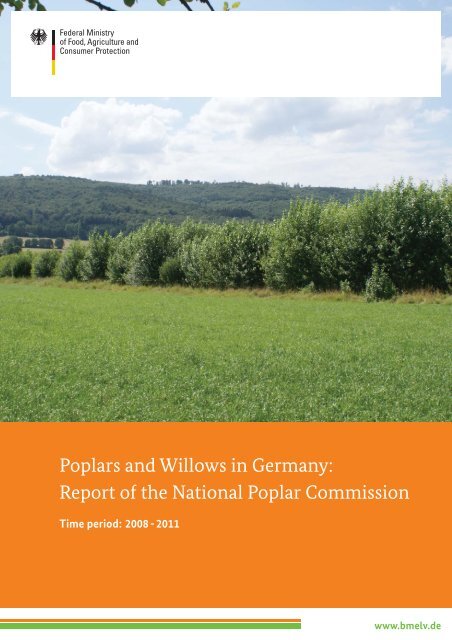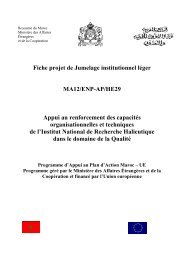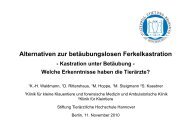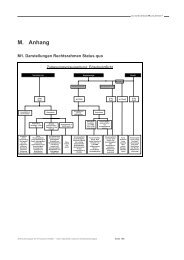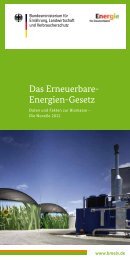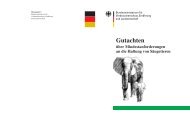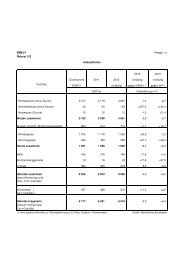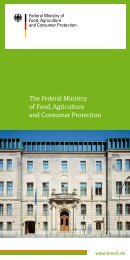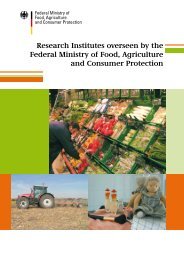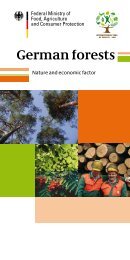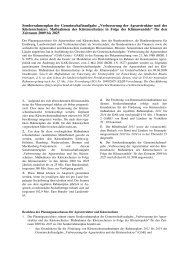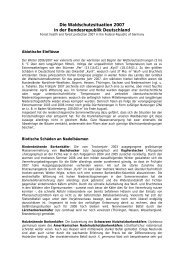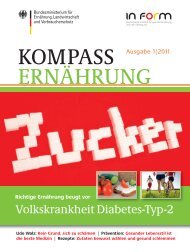Poplars and Willows in Germany: Report of the National ... - BMELV
Poplars and Willows in Germany: Report of the National ... - BMELV
Poplars and Willows in Germany: Report of the National ... - BMELV
You also want an ePaper? Increase the reach of your titles
YUMPU automatically turns print PDFs into web optimized ePapers that Google loves.
<strong>Poplars</strong> <strong>and</strong> <strong>Willows</strong> <strong>in</strong> <strong>Germany</strong>:<br />
<strong>Report</strong> <strong>of</strong> <strong>the</strong> <strong>National</strong> Poplar Commission<br />
Time period: 2008 - 2011<br />
www.bmelv.de
Federal M<strong>in</strong>istry <strong>of</strong><br />
Food, Agriculture<br />
<strong>and</strong> Consumer Protection<br />
<strong>Poplars</strong> <strong>and</strong> <strong>Willows</strong> <strong>in</strong> <strong>Germany</strong>:<br />
<strong>Report</strong> <strong>of</strong> <strong>the</strong> <strong>National</strong> Poplar Commission<br />
Time period: 2008-2011<br />
...
- 2 -<br />
Editor:<br />
Johann-He<strong>in</strong>rich von Thünen-Institut (vTI)<br />
Bundesforschungs<strong>in</strong>stitut für Ländliche Räume, Wald und Fischerei<br />
(Dr. Georg v. Wühlisch)<br />
Institut für Forstgenetik<br />
Sieker L<strong>and</strong>str. 2<br />
22927 Großhansdorf<br />
...
Poplar Commission<br />
<strong>of</strong> <strong>the</strong><br />
Federal Republic <strong>of</strong> <strong>Germany</strong><br />
<strong>Poplars</strong> <strong>and</strong> <strong>Willows</strong> <strong>in</strong> <strong>Germany</strong>:<br />
<strong>Report</strong> <strong>of</strong> <strong>the</strong> <strong>National</strong> Poplar Commission<br />
Time period: 2008-2011<br />
- 3 -<br />
Bonn, June 2012<br />
...
- 4 -<br />
Poplar Commission <strong>of</strong> <strong>the</strong> Federal Republic <strong>of</strong> <strong>Germany</strong><br />
<strong>Poplars</strong> <strong>and</strong> <strong>Willows</strong> <strong>in</strong> <strong>Germany</strong>:<br />
<strong>Report</strong> <strong>of</strong> <strong>the</strong> <strong>National</strong> Poplar Commission<br />
Time period: 2008 bis 2011<br />
Contents<br />
I POLICIES AND LEGISLATION.......................................................................... 6<br />
Policies 6<br />
a) Cultivation <strong>of</strong> poplars <strong>and</strong> willows <strong>in</strong> short-rotation coppices on arable l<strong>and</strong> 6<br />
b) Genetic conservation <strong>of</strong> black poplar (Populus nigra L.) 6<br />
c) Agr<strong>of</strong>orestry systems 7<br />
Legal measures 7<br />
II STATISTICAL AND ECONOMIC DATA............................................................. 8<br />
Statistical data 8<br />
Production 8<br />
Imports <strong>and</strong> exports 9<br />
Trends 9<br />
III TECHNICAL DATA............................................................................................. 9<br />
Identification, registration <strong>and</strong> plant variety protection 9<br />
a) Identification 9<br />
b) Approvals 10<br />
c) Registration 11<br />
d) Arboriculture Register 11<br />
e) Plant variety protection 11<br />
Cultivation 11<br />
a) Conventional rotation 11<br />
b) Short rotation coppices 11<br />
...
- 5 -<br />
Breed<strong>in</strong>g <strong>and</strong> selection 13<br />
c) Conventional rotation 13<br />
d) Short rotation 13<br />
Protection measures 13<br />
Exploitation <strong>and</strong> utilisation 14<br />
a) Exploitation 14<br />
b) Utilisation 14<br />
Scientific studies <strong>and</strong> o<strong>the</strong>r activities 14<br />
GENERAL INFORMATION............................................................................................. 15<br />
<strong>National</strong> Poplar Commission 15<br />
Relations with o<strong>the</strong>r countries 15<br />
Annexes<br />
...
I Policies <strong>and</strong> Legislation<br />
- 6 -<br />
Policies<br />
a) Cultivation <strong>of</strong> poplars <strong>and</strong> willows <strong>in</strong> short-rotation coppices on arable l<strong>and</strong><br />
Dur<strong>in</strong>g <strong>the</strong> period under review, <strong>the</strong> cultivation <strong>of</strong> poplars <strong>and</strong> willows <strong>in</strong> short-rotation coppices<br />
(SRC) <strong>in</strong>creas<strong>in</strong>gly developed <strong>in</strong>to a practicable form <strong>of</strong> energy wood production. This applies<br />
to <strong>the</strong> supply with appropriate plant<strong>in</strong>g material, to <strong>the</strong> availability <strong>of</strong> specialised contractors for<br />
plant<strong>in</strong>g <strong>and</strong> harvest<strong>in</strong>g measures <strong>and</strong> to practical knowledge with regard to establish<strong>in</strong>g <strong>and</strong><br />
ma<strong>in</strong>ta<strong>in</strong><strong>in</strong>g such plantations. But knowledge on <strong>the</strong> development <strong>of</strong> such plantations <strong>in</strong> <strong>the</strong><br />
course <strong>of</strong> <strong>the</strong>ir calculated st<strong>and</strong> time <strong>and</strong> on <strong>the</strong> predictability <strong>of</strong> <strong>the</strong> expected biomass yields<br />
related to a certa<strong>in</strong> site type is still lack<strong>in</strong>g. In addition, <strong>the</strong>re is a dem<strong>and</strong> for productive poplar<br />
<strong>and</strong> willow clones. Several projects were supported with experimental plantations by <strong>the</strong><br />
Fachagentur Nachwachsende Rohst<strong>of</strong>fe (Agency for Renewable Resources) <strong>and</strong> o<strong>the</strong>r<br />
<strong>in</strong>stitutions with a view to answer<strong>in</strong>g questions about <strong>the</strong> practical cultivation, pr<strong>of</strong>itability <strong>and</strong><br />
<strong>the</strong> selection <strong>of</strong> suitable species <strong>and</strong> varieties.<br />
For <strong>the</strong> production <strong>of</strong> renewable energy, this form <strong>of</strong> l<strong>and</strong> use is generally recognised as <strong>the</strong><br />
form that comb<strong>in</strong>es high CO2 fixation with low CO2 avoidance costs <strong>and</strong> that can at <strong>the</strong> same<br />
time use agricultural marg<strong>in</strong>al l<strong>and</strong> <strong>and</strong> is <strong>the</strong>refore not necessarily <strong>in</strong> direct competition with<br />
food production. The ability <strong>of</strong> poplars <strong>and</strong> willows to fix atmospheric nitrogen allows for <strong>the</strong><br />
production <strong>of</strong> large amounts <strong>of</strong> biomass without fur<strong>the</strong>r <strong>in</strong>creas<strong>in</strong>g nitrogen deposition <strong>in</strong> soils<br />
<strong>and</strong> groundwater. It is this ability <strong>in</strong> particular that makes biomass production <strong>in</strong> short-rotation<br />
coppices so susta<strong>in</strong>able. The total area <strong>of</strong> short-rotation coppices <strong>in</strong> <strong>Germany</strong> has <strong>in</strong>creased to<br />
4,000-5,000 ha <strong>and</strong> cont<strong>in</strong>ues to <strong>in</strong>crease significantly.<br />
Although <strong>the</strong> promotional policy under <strong>the</strong> Renewable Energies Act (EEG) has <strong>in</strong>creased <strong>the</strong><br />
prices <strong>of</strong> woody solid fuels (firewood, wood chips, pellets), <strong>the</strong>y are still only 60% <strong>of</strong> <strong>the</strong> price<br />
<strong>of</strong> natural gas <strong>and</strong> 50% <strong>of</strong> <strong>the</strong> price <strong>of</strong> heat<strong>in</strong>g oil <strong>and</strong> are less volatile.<br />
b) Genetic conservation <strong>of</strong> black poplar (Populus nigra L.)<br />
Most pure black poplar occurrences only consist <strong>of</strong> relict st<strong>and</strong>s with over-mature trees. Efforts<br />
have been cont<strong>in</strong>ued to preserve <strong>the</strong> rema<strong>in</strong><strong>in</strong>g population through <strong>in</strong> situ <strong>and</strong> ex situ measures.<br />
The gene banks <strong>of</strong> several Länder (NW, RP, HE, SN, BB, ST) conta<strong>in</strong> black poplars <strong>of</strong> certified<br />
purity <strong>and</strong> orig<strong>in</strong> for renaturation measures <strong>in</strong> <strong>the</strong> respective region. Black poplar st<strong>and</strong>s have<br />
been approved for harvest<strong>in</strong>g generative reproductive material for genetic conservation purposes<br />
<strong>in</strong> accordance with <strong>the</strong> Act on Forest Reproductive Material (Forstvermehrungsgutgesetz -
- 7 -<br />
FoVG). Seed samples from gene conservation units have been made available to American<br />
poplar breeders.<br />
c) Agr<strong>of</strong>orestry systems<br />
Accord<strong>in</strong>g to <strong>the</strong> EURopean AgroForestry Federation (EURAFF), <strong>the</strong> term agr<strong>of</strong>orestry system<br />
(AFS) means that field crops (trees) <strong>and</strong> agricultural crops are cultivated on <strong>the</strong> very same plot.<br />
Positive <strong>in</strong>teractions between woodl<strong>and</strong> <strong>and</strong> arable crops require that <strong>the</strong> entire grow<strong>in</strong>g area be<br />
regarded as a so-called agr<strong>of</strong>orestry system. In addition to ecological (ecotonal structures,<br />
biotope network) <strong>and</strong> climatic (<strong>in</strong>creased roughness <strong>of</strong> <strong>the</strong> l<strong>and</strong>scape) benefits, timber<br />
production <strong>and</strong> agricultural crop rotation patterns have also been <strong>in</strong>tegrated <strong>in</strong>to this system. The<br />
cultivation <strong>of</strong> poplars, willows <strong>and</strong> black locust <strong>in</strong> rows <strong>in</strong> short-rotation plantations alternat<strong>in</strong>g<br />
with agricultural crops is studied as a new form <strong>of</strong> cultivation <strong>in</strong> <strong>the</strong> scope <strong>of</strong> various projects.<br />
The positive effects are very promis<strong>in</strong>g.<br />
Legal measures<br />
With <strong>the</strong> elim<strong>in</strong>ation <strong>of</strong> <strong>the</strong> compulsory set-aside under Regulation (EC) No 73/2009, areas with<br />
short-rotation plantations <strong>and</strong> agr<strong>of</strong>orestry systems have been classified as eligible permanent<br />
crops. The rotation periods must be shorter than 20 years each.<br />
In order to ma<strong>in</strong>ta<strong>in</strong> this eligibility for aid, <strong>the</strong> tree species poplar, willow, black locust, birch,<br />
alder <strong>and</strong> ash (CN code 0602 90 41) may be cultivated <strong>in</strong> short-rotation plantations <strong>and</strong><br />
agr<strong>of</strong>orestry systems.<br />
By amendment to <strong>the</strong> Federal Forest Act (BWaldG) <strong>of</strong> 31 July 2010, short rotation plantations<br />
<strong>and</strong> agr<strong>of</strong>orestry systems are no longer considered forest (Article 2 (2) no 1 BWaldG). This<br />
implies that no afforestation authorisation is required for <strong>the</strong> establishment <strong>of</strong> short rotation<br />
plantations outside forest l<strong>and</strong>. The area can also be converted back for food production at any<br />
time without hav<strong>in</strong>g to apply for a clear<strong>in</strong>g <strong>and</strong> conversion authorisation. This approach is meant<br />
to facilitate <strong>the</strong> creation <strong>of</strong> short-rotation plantations outside forests. On <strong>the</strong> o<strong>the</strong>r h<strong>and</strong>, <strong>the</strong><br />
establishment <strong>of</strong> short rotation plantations <strong>in</strong> forests is not regarded as regular forest<br />
management. A forest conversion authorisation would be necessary for this purpose.<br />
An environmental risk assessment (ERA) is only required for areas greater 50 ha, but every short<br />
rotation plantation or agr<strong>of</strong>orestry system must be regarded as an <strong>in</strong>dividual case. It is <strong>the</strong>refore<br />
advisable to notify such plantations to <strong>the</strong> lower nature conservation authority or <strong>the</strong> competent<br />
agricultural agency.
- 8 -<br />
Permanent grassl<strong>and</strong> areas are subject to <strong>the</strong> obligation to conserve grassl<strong>and</strong>s. Eligible<br />
permanent grassl<strong>and</strong> areas must only be converted <strong>in</strong>to short rotation plantations to a m<strong>in</strong>or<br />
extent, as <strong>the</strong>y are considered permanent cultures (see cross-compliance/obligation to ma<strong>in</strong>ta<strong>in</strong><br />
grassl<strong>and</strong>s under Regulation (EC) No 73/2009 <strong>and</strong> Regulation (EC) No 1122/2009).<br />
The provisions <strong>of</strong> <strong>the</strong> Act on Forest Reproductive Material (FoVG) also apply to short-rotation<br />
plantations outside forests.<br />
II Statistical <strong>and</strong> Economic Data<br />
Statistical data<br />
Plant<strong>in</strong>g <strong>of</strong> poplars <strong>and</strong> willows <strong>in</strong> <strong>Germany</strong>’s forests is presently rare. This is primarily due to<br />
<strong>the</strong> as yet low sales potential for poplar wood <strong>and</strong> <strong>the</strong> clearcut-free cont<strong>in</strong>uous cover forest<br />
management. Aspens <strong>and</strong> balsam poplars are <strong>in</strong>troduced as pioneer crops <strong>in</strong> mixed st<strong>and</strong>s only<br />
on calamity areas or o<strong>the</strong>r afforestation areas. It is <strong>the</strong>refore difficult to record area percentage<br />
figures. The most recent <strong>National</strong> Forest Inventory cites hardwoods with short life spans (birch,<br />
alder, poplar, willow, rowan <strong>and</strong> o<strong>the</strong>r deciduous trees) <strong>in</strong> summary at 10%. <strong>Poplars</strong> <strong>and</strong> aspens<br />
take up an area <strong>of</strong> up to 100,000 hectares. <strong>Willows</strong>, by contrast, are restricted to only a few wet<br />
<strong>and</strong> extensive sites.<br />
The area <strong>of</strong> biomass plantations with poplar <strong>and</strong> willows on formerly agriculturally used nonforest<br />
areas has dist<strong>in</strong>ctly <strong>in</strong>creased <strong>and</strong> is now between 4,000 <strong>and</strong> 5,000 hectares. A great<br />
<strong>in</strong>crease <strong>in</strong> <strong>the</strong>se areas is anticipated s<strong>in</strong>ce <strong>the</strong> regulatory framework guarantees that <strong>the</strong>y are<br />
considered agricultural areas <strong>and</strong> are <strong>the</strong>refore eligible for aid.<br />
Production<br />
The cultivation <strong>of</strong> poplar <strong>and</strong> willows as a basis for raw materials is <strong>of</strong> m<strong>in</strong>or importance <strong>in</strong> <strong>the</strong><br />
Federal Republic <strong>of</strong> <strong>Germany</strong>. We have no precise data on <strong>the</strong> current levels <strong>of</strong> poplar raw wood<br />
fell<strong>in</strong>g s<strong>in</strong>ce poplar fell<strong>in</strong>gs <strong>and</strong> sales are recorded <strong>and</strong> entered <strong>in</strong> <strong>the</strong> databases toge<strong>the</strong>r with <strong>the</strong><br />
timber species group 'beech'. Annual poplar fell<strong>in</strong>g is estimated at 150,000 to 300,000 m 3 , as old<br />
st<strong>and</strong>s have been <strong>in</strong>creas<strong>in</strong>gly used <strong>and</strong> have not been replaced by new plant<strong>in</strong>gs. There are no<br />
separate records on <strong>the</strong> use <strong>of</strong> poplar raw wood.
- 9 -<br />
The timber volume <strong>of</strong> approx. 50,000 t that is annually produced <strong>in</strong> short-rotation plantations<br />
concerns <strong>the</strong> energy market <strong>and</strong> is comparatively <strong>in</strong>significant <strong>in</strong> this context as compared to <strong>the</strong><br />
quantities <strong>of</strong> imported wood pellets which already amount to several million tonnes.<br />
Imports <strong>and</strong> exports<br />
The Federal Republic <strong>of</strong> <strong>Germany</strong>'s foreign trade <strong>in</strong> poplar timber is <strong>of</strong> m<strong>in</strong>or significance, as<br />
<strong>Germany</strong> has no poplar timber-based <strong>in</strong>dustries. A separate market for poplar timber has not<br />
developed to any major significance <strong>in</strong> <strong>Germany</strong>. But occasionally, export prices <strong>of</strong> approx.<br />
€ 50/m 3 were realised near harbours for st<strong>and</strong>ard poplar log varieties.<br />
Trends<br />
Interest<strong>in</strong>g markets are <strong>in</strong>creas<strong>in</strong>gly develop<strong>in</strong>g for energy use <strong>of</strong> poplar <strong>and</strong> willow timber <strong>in</strong><br />
<strong>the</strong> form <strong>of</strong> wood chips to be used for <strong>the</strong> comb<strong>in</strong>ed generation <strong>of</strong> power <strong>and</strong> heat <strong>in</strong> power<br />
stations <strong>in</strong> municipalities with district heat<strong>in</strong>g networks or o<strong>the</strong>r heat users.<br />
III Technical Data<br />
Identification, registration <strong>and</strong> plant variety protection<br />
a) Identification<br />
Under <strong>the</strong> FastWOOD project funded by <strong>the</strong> <strong>BMELV</strong>, <strong>the</strong> methods for <strong>the</strong> identification <strong>of</strong><br />
poplar clones have been extended by molecular methods. There are now reliable identification<br />
methods for all marketable clones <strong>and</strong> varieties. Reference databases are <strong>in</strong> <strong>the</strong> mak<strong>in</strong>g. These<br />
methods allow for <strong>the</strong> reliable <strong>and</strong> <strong>in</strong>creas<strong>in</strong>gly cost-effective control <strong>of</strong> <strong>the</strong> breeders' market<strong>in</strong>g<br />
rights for <strong>the</strong>se varieties.<br />
A common method uses microsatellite DNA polymorphisms. These are short, non-cod<strong>in</strong>g DNA<br />
sequences that are <strong>of</strong>ten repeated <strong>in</strong> <strong>the</strong> genome <strong>of</strong> an organism <strong>in</strong> non-cod<strong>in</strong>g regions <strong>of</strong> <strong>the</strong><br />
chloroplasts – such as <strong>the</strong> nuclear DNA (syn. SSR – Simple Sequence Repeats or SSLP – Simple<br />
sequence length polymorphism). These DNA fragments are electrophoretically separated <strong>in</strong> a gel<br />
matrix <strong>and</strong> show characteristic b<strong>and</strong><strong>in</strong>g patterns for <strong>the</strong> exam<strong>in</strong>ed genotypes. Ano<strong>the</strong>r method<br />
uses variations <strong>of</strong> <strong>in</strong>dividual base pairs <strong>in</strong> a DNA str<strong>and</strong>, referred to as s<strong>in</strong>gle nucleotide<br />
polymorphisms (SNP marker). The variation is identified by way <strong>of</strong> sequenc<strong>in</strong>g <strong>the</strong> nucleotide<br />
base pairs <strong>and</strong> shows genotype-specific sequences that allow for exact dist<strong>in</strong>ctions. Moreover,<br />
knowledge about species-characteristic microsatellite markers or SNPs allows <strong>the</strong> determ<strong>in</strong>ation
- 10 -<br />
<strong>of</strong> <strong>the</strong> parent species <strong>of</strong> species hybrids, thus help<strong>in</strong>g to reconstruct <strong>the</strong> genealogy <strong>of</strong> suitable<br />
poplar hybrids. These <strong>in</strong>struments support efficient breed<strong>in</strong>g activities.<br />
Biochemical analysis methods are also used for <strong>the</strong> conservation <strong>of</strong> <strong>the</strong> European black poplar<br />
with a view to ensur<strong>in</strong>g that only pure species material is conserved. S<strong>in</strong>ce <strong>the</strong> European black<br />
poplar crosses spontaneously with <strong>the</strong> widespread hybrid clones, genetic mix<strong>in</strong>g with native<br />
black poplars cannot be excluded.<br />
b) Approvals<br />
The follow<strong>in</strong>g basic material for <strong>the</strong> production <strong>of</strong> forest reproductive material was approved <strong>in</strong><br />
<strong>the</strong> period under review on <strong>the</strong> basis <strong>of</strong> experimental plantations under <strong>the</strong> provisions <strong>of</strong> <strong>the</strong> Act<br />
on Forest Reproductive Material (Forstvermehrungsgutgesetz - FoVG) <strong>and</strong> <strong>the</strong> accompany<strong>in</strong>g<br />
ord<strong>in</strong>ances <strong>in</strong> <strong>the</strong> category "Tested Reproductive Material".<br />
Clone name Cross Gender Number Time limit<br />
Matrix 11<br />
P. maximowiczii × P.<br />
trichocarpa 95304 30.06.2021<br />
Matrix 24<br />
P. maximowiczii × P.<br />
trichocarpa 95305 30.06.2021<br />
Matrix 49<br />
P. maximowiczii × P.<br />
trichocarpa 95306 30.06.2021<br />
Ahle 1<br />
P. tremula × P.<br />
tremula m 98404 30.06.2018<br />
Ahle 2<br />
P. tremula × P.<br />
tremula m 98405 30.06.2018<br />
Ahle 13<br />
P. tremula × P.<br />
tremula m 98408 30.06.2018<br />
Ahle 4<br />
P. tremula × P.<br />
tremula m 98406 30.06.2018<br />
Ahle 5<br />
P. tremula × P.<br />
tremula f 98407 30.06.2018<br />
Ahle 16<br />
P. tremula × P.<br />
tremula m 98409 30.06.2018<br />
Ahle 17<br />
P. tremula × P.<br />
tremula m 98410 30.06.2018<br />
Münden 2<br />
P. tremula × P.<br />
tremuloides m 98506 30.06.2018<br />
Münden 6<br />
P. tremula × P.<br />
tremuloides m 98507 30.06.2018<br />
Münden 7<br />
P. tremula × P.<br />
tremuloides f 98508 30.06.2018<br />
Münden 11<br />
P. tremula × P.<br />
tremuloides f 98509 30.06.2018<br />
Münden 13<br />
P. tremula × P.<br />
tremuloides m 98510 30.06.2018<br />
Münden 16<br />
P. tremula × P.<br />
tremuloides m 98511 30.06.2018<br />
Münden 20<br />
P. tremula × P.<br />
tremuloides f 98512 30.06.2018
- 11 -<br />
c) Registration<br />
S<strong>in</strong>ce 2011, <strong>the</strong> Federal Agency for Agriculture <strong>and</strong> Food (BLE) <strong>in</strong> Bonn is ma<strong>in</strong>ta<strong>in</strong><strong>in</strong>g <strong>the</strong><br />
register <strong>of</strong> clones, clonal mixtures <strong>and</strong> parents <strong>of</strong> family approved <strong>in</strong> <strong>Germany</strong> by <strong>the</strong> authorities<br />
competent under L<strong>and</strong> law (www.ble.de).<br />
Under Article 4 <strong>of</strong> <strong>the</strong> Act on Forest Reproductive Material (FoVG), approvals <strong>of</strong> <strong>the</strong>se species<br />
<strong>of</strong> basic material may only be granted <strong>in</strong> <strong>the</strong> category "Tested". The vegetative production <strong>of</strong><br />
forest reproductive material to be placed on <strong>the</strong> market also must be based on basic material <strong>of</strong><br />
this category (Article 7 FoVG).<br />
A list <strong>of</strong> poplar clones, clonal mixtures <strong>and</strong> family parents can be downloaded from<br />
http://www.ble.de/SharedDocs/Downloads/02_Kontrolle/07_SaatUndPflanzgut/Pappelklone_mischungen.pdf?__blob=publicationFile.<br />
An overview <strong>of</strong> poplar stool beds <strong>and</strong> <strong>the</strong> competent L<strong>and</strong> agencies can be downloaded from<br />
http://www.ble.de/SharedDocs/Downloads/02_Kontrolle/07_SaatUndPflanzgut/Pappelmutterquartiere.pdf?__blob=publicationFile.<br />
d) Arboriculture Register<br />
Approved poplar clones <strong>and</strong> clonal mixtures are entered <strong>in</strong> an Arboriculture Register. The<br />
Arboriculture Register for poplars is ma<strong>in</strong>ta<strong>in</strong>ed by<br />
Regierungspräsidium Kassel, Ste<strong>in</strong>weg 6, D-34117 Kassel.<br />
e) Plant variety protection<br />
Due to <strong>the</strong> low trade volume for poplar reproductive material <strong>and</strong> <strong>the</strong> comparatively high costs,<br />
variety protection is not <strong>of</strong>ten claimed.<br />
Cultivation<br />
a) Conventional rotation<br />
<strong>Poplars</strong>, aspens <strong>and</strong> willows are not cultivated to any notable extent <strong>in</strong> conventional rotation.<br />
Due to <strong>the</strong> better economic situation <strong>of</strong> forestry hold<strong>in</strong>gs as a result <strong>of</strong> higher timber prices, <strong>the</strong>re<br />
is a greater <strong>in</strong>terest <strong>in</strong> plant<strong>in</strong>g pioneer crops. These allow earlier exploitations <strong>and</strong> pr<strong>of</strong>its.<br />
Balsam poplar hybrids as well as aspens <strong>and</strong> aspen hybrids (P. tremula × P. tremuloides) are<br />
particularly suitable as pioneer tree species. Thus, aspen hybrid species such as 'Holsatia', for<br />
<strong>in</strong>stance, are sell<strong>in</strong>g better than <strong>in</strong> past decades.<br />
b) Short rotation coppices<br />
The various government-supported cultivation, breed<strong>in</strong>g <strong>and</strong> test<strong>in</strong>g programmes <strong>in</strong>clude, for<br />
example, ProLoc <strong>and</strong> FastWood. O<strong>the</strong>r projects can be found at<br />
http://www.nachwachsenderohst<strong>of</strong>fe.de/projekte-foerderung/projekte/. Short rotation coppices<br />
were cont<strong>in</strong>ued <strong>and</strong> exp<strong>and</strong>ed <strong>in</strong> Hesse, Lower Saxony, Saxony, Bavaria <strong>and</strong>, above all,
- 12 -<br />
Br<strong>and</strong>enburg so that about half <strong>of</strong> <strong>the</strong> 4,000 ha <strong>of</strong> short-rotation plantation area <strong>in</strong> <strong>Germany</strong> are<br />
established <strong>the</strong>re.<br />
The results <strong>of</strong> <strong>the</strong> ProLoc project reveal that biomass growth is significantly dependent on water<br />
supply. An average water supply <strong>of</strong> 300 l/m² dur<strong>in</strong>g <strong>the</strong> vegetation period <strong>and</strong> water-hold<strong>in</strong>g<br />
soils can produce yields <strong>of</strong> 10 t <strong>of</strong> dry matter per hectare annually. With high precipitation or<br />
groundwater impact also guarantee<strong>in</strong>g a cont<strong>in</strong>uous growth <strong>in</strong> dry periods, <strong>the</strong> yields can even<br />
be 20 t <strong>and</strong> higher; whereas with a poorer water supply, <strong>the</strong> annual dry mass <strong>in</strong>crement per<br />
hectare can be 6 t or less.<br />
The <strong>in</strong>vestment costs for establish<strong>in</strong>g a plantation are high <strong>and</strong> vary depend<strong>in</strong>g on <strong>the</strong> tree<br />
species <strong>and</strong> <strong>the</strong> number <strong>of</strong> plants, which, <strong>in</strong> turn, depends on <strong>the</strong> utilisation purpose <strong>of</strong> <strong>the</strong><br />
woody biomass produced. Total costs <strong>of</strong> € 1,800 – 5,500 (establishment, operat<strong>in</strong>g <strong>and</strong><br />
harvest<strong>in</strong>g costs) per hectare are calculated for biomass production with a large number <strong>of</strong> plants<br />
<strong>and</strong> short rotation periods, establishment costs for <strong>in</strong>dustrial utilisation with lower numbers <strong>of</strong><br />
plants <strong>and</strong> longer rotation periods are € 1,600 per hectare, <strong>in</strong> both cases not <strong>in</strong>clud<strong>in</strong>g fenc<strong>in</strong>g,<br />
which can be calculated at an additional € 1,000 per hectare.<br />
In addition to <strong>in</strong>vestment costs, harvest<strong>in</strong>g <strong>and</strong> transport are also major cost factors that heavily<br />
depend on <strong>the</strong> production target. Harvest<strong>in</strong>g costs <strong>of</strong> € 45-82/t <strong>of</strong> dry mass have been estimated<br />
if specially constructed harvest<strong>in</strong>g mach<strong>in</strong>ery to harvest wood chips for energy exploitation at a<br />
maximum 4-year growth is used. These costs could be reduced by improved capacity utilisation<br />
<strong>of</strong> <strong>the</strong> harvest<strong>in</strong>g mach<strong>in</strong>ery. Longer rotation periods result <strong>in</strong> thicker harvest material, which<br />
results <strong>in</strong> higher harvest<strong>in</strong>g costs.<br />
To evaluate <strong>the</strong> economic situation <strong>of</strong> plantations for energy use <strong>of</strong> woody biomass <strong>and</strong> an<br />
average plantation volume yield (10 t/ha) <strong>and</strong> lifetime (seven 3-4 year rotations), production<br />
costs between 30 <strong>and</strong> 45 €/t absolute dry weight woody biomass are calculated. If <strong>the</strong> operat<strong>in</strong>g<br />
risks are not taken <strong>in</strong>to account <strong>and</strong> revenues <strong>of</strong> € 50/t absolute dry weight are calculated for <strong>the</strong><br />
produced biomass, annuities (at 3.5% <strong>in</strong>terest) <strong>of</strong> between 125 <strong>and</strong> 250 €/ha can be anticipated.<br />
The current prices <strong>of</strong> € 90/t absolute dry weight for wood chips will result <strong>in</strong> higher revenues.<br />
Under <strong>the</strong> present circumstances, short rotation plantations are no competition to agricultural<br />
food production. It seems reasonable to operate short-rotation plantations on agricultural<br />
marg<strong>in</strong>al soils with water supplies that are too low or too high <strong>and</strong> on poor soils.<br />
Biotic damages are a risk factor. Increased spread <strong>of</strong> plantation areas could cause significant<br />
economic damages due to better development opportunities <strong>of</strong> previously <strong>in</strong>significant harmful<br />
organisms. The primary risk is, however, <strong>the</strong> price at which <strong>the</strong> produced material can be<br />
utilised. If oil prices rema<strong>in</strong> at <strong>the</strong>ir present high for a long time or above it temporarily, woody<br />
biomass could be competitive as an energy source, particularly if rationalisation potentials could<br />
be developed for seedl<strong>in</strong>g production, harvest<strong>in</strong>g <strong>and</strong> transport at <strong>in</strong>creas<strong>in</strong>g utilisation.
Breed<strong>in</strong>g <strong>and</strong> selection<br />
c) Conventional rotation<br />
- 13 -<br />
No breed<strong>in</strong>g or selection took place for exploitation <strong>in</strong> conventional cultivation dur<strong>in</strong>g <strong>the</strong> period<br />
under report. Genetic resources <strong>of</strong> <strong>the</strong> black poplar (P. nigra) <strong>in</strong> <strong>the</strong> form <strong>of</strong> pollen <strong>and</strong> seed<br />
were provided for breed<strong>in</strong>g work <strong>in</strong> <strong>the</strong> USA.<br />
d) Short rotation<br />
In <strong>the</strong> course <strong>of</strong> production <strong>of</strong> renewable energies, <strong>the</strong> cultivation <strong>of</strong> poplars, aspens <strong>and</strong> willows<br />
is ga<strong>in</strong><strong>in</strong>g <strong>in</strong>creas<strong>in</strong>g <strong>in</strong>terest. There has been such great dem<strong>and</strong> for seedl<strong>in</strong>gs <strong>in</strong> <strong>Germany</strong> that it<br />
could not be satisfied by domestic nurseries for a time that poplar seedl<strong>in</strong>gs had to be imported<br />
from Austria, Hungary, Italy <strong>and</strong> France <strong>and</strong> willow cutt<strong>in</strong>gs from Sweden. The dem<strong>and</strong> for<br />
aspens could also not be satisfied.<br />
Accord<strong>in</strong>g to <strong>the</strong> guidebook Energieholzproduktion <strong>in</strong> der L<strong>and</strong>wirtschaft (Energy Timber<br />
Production <strong>in</strong> Agriculture; 3 rd edition, 2009; author: M. H<strong>of</strong>mann) published by Fachagentur<br />
Nachwachsende Rohst<strong>of</strong>fe (Agency for Renewable Resources), eight poplar varieties are<br />
suitable: Hybrids 275 (Syn. NE 42), Max (multiclonal variety), P. koreana*, 10/85, 20/85*,<br />
Androscogg<strong>in</strong>, Trichobel <strong>and</strong> Muhle Larsen <strong>and</strong> six willow varieties: Björn, Tora, Zieverich,<br />
Tordis, Inger <strong>and</strong> Sven for cultivation <strong>in</strong> short-rotation plantations. In 2011, about 80% Max<br />
clones <strong>and</strong> 15% Hybrids 275 were used. As for willows, <strong>the</strong> shift <strong>in</strong> preferences was even more<br />
significant. The clones Tordis <strong>and</strong> Inger with 35% each <strong>and</strong> Tora with 20% are used most,<br />
whereas clone Sven <strong>and</strong> new breed Klara only amount to 5% each (oral <strong>in</strong>formation by<br />
C. Neumeister). Many varieties have not yet demonstrated <strong>the</strong>ir suitability on agricultural sites,<br />
however. This clearly demonstrates that <strong>the</strong>re is not only a great dem<strong>and</strong> for varieties but that<br />
<strong>the</strong>se must also be tested for suitability. This underl<strong>in</strong>es <strong>the</strong> importance <strong>of</strong> projects like ProLoc<br />
<strong>in</strong> <strong>the</strong> scope <strong>of</strong> which <strong>the</strong> suitability <strong>of</strong> clones is tested on a wide variety <strong>of</strong> sites <strong>in</strong> various<br />
German regions.<br />
Protection measures<br />
Considerable damage events are not known for poplars <strong>and</strong> willows. Protective measures must,<br />
however, be taken, primarily <strong>in</strong> <strong>the</strong> first year <strong>of</strong> plant<strong>in</strong>g aga<strong>in</strong>st brows<strong>in</strong>g by game with fenc<strong>in</strong>g,<br />
aga<strong>in</strong>st damage done by rodents <strong>and</strong> aga<strong>in</strong>st compet<strong>in</strong>g vegetation. Chrysomela (=Melasoma)<br />
populi L. has done some damage, particularly feed<strong>in</strong>g damage on <strong>the</strong> newly flush<strong>in</strong>g coppice
- 14 -<br />
shoots after harvest<strong>in</strong>g. Feed<strong>in</strong>g damage by Chrysomela vig<strong>in</strong>tipunctata can also reduce growth<br />
<strong>in</strong>crement <strong>in</strong> <strong>in</strong>dividual cases. After several years, however, <strong>the</strong>re seems to be a balance between<br />
<strong>the</strong> beetles <strong>and</strong> <strong>the</strong>ir enemies so that damages become tolerable without protection measures<br />
(written communication by K. Döhrer). In years with extreme spr<strong>in</strong>g aridity, mortality was high<br />
(<strong>in</strong> parts even total). Supplementary irrigation, particularly dur<strong>in</strong>g <strong>the</strong> young growth phase, is<br />
recommended to safeguard successful regeneration <strong>and</strong> to <strong>in</strong>crease <strong>the</strong> <strong>in</strong>crement.<br />
Most occurrences <strong>of</strong> pure black poplars are damaged by fungi <strong>and</strong> <strong>in</strong>sects. This particularly<br />
applies to foliar rust caused by Melampsora larici-popul<strong>in</strong>a. The over-maturity <strong>of</strong> <strong>the</strong> trees <strong>in</strong><br />
<strong>the</strong> occurrences, mostly <strong>in</strong> relict st<strong>and</strong>s, can be considered <strong>the</strong> cause <strong>of</strong> <strong>the</strong> alarm<strong>in</strong>g health<br />
condition. The genetic resources must <strong>the</strong>refore be protected <strong>and</strong> regeneration measures<br />
<strong>in</strong>troduced.<br />
Exploitation <strong>and</strong> utilisation<br />
a) Exploitation<br />
<strong>Poplars</strong> <strong>and</strong> willows grown <strong>in</strong> conventional rotation periods are exploited accord<strong>in</strong>g to normal<br />
forestry practices. Poplar raw wood is graded accord<strong>in</strong>g to <strong>the</strong> statutory provisions on raw wood<br />
grades.<br />
The woody biomass produced <strong>in</strong> short-rotation plantations is used <strong>in</strong> <strong>the</strong> form <strong>of</strong> wood chips,<br />
e.g. for wood-based materials, but ma<strong>in</strong>ly for energy production.<br />
b) Utilisation<br />
The biomass produced <strong>in</strong> short-rotation plantations is mostly used as solid fuel, which is ma<strong>in</strong>ly<br />
burnt as wood chips <strong>in</strong> adapted boiler systems. With greater volumes <strong>of</strong> woody biomass,<br />
<strong>in</strong>creased pelletisation would be conceivable. Methods for <strong>the</strong> gasification <strong>of</strong> woody biomass<br />
(pyrolysis) or <strong>the</strong> liquefaction <strong>of</strong> fuels (Fischer-Tropsch process) have not yet been developed to<br />
<strong>the</strong> po<strong>in</strong>t <strong>of</strong> practical application.<br />
Scientific studies <strong>and</strong> o<strong>the</strong>r activities<br />
Old poplar tests, clone collections <strong>and</strong> neglected mo<strong>the</strong>r plantations have been exam<strong>in</strong>ed <strong>and</strong><br />
secured with<strong>in</strong> <strong>the</strong> scope <strong>of</strong> new breed<strong>in</strong>g activities <strong>and</strong> <strong>the</strong> FastWOOD project. Many <strong>of</strong> <strong>the</strong><br />
exist<strong>in</strong>g clones have been identified with <strong>the</strong> help <strong>of</strong> molecular markers. The clones are also<br />
tested for <strong>the</strong>ir suitability for biomass production <strong>in</strong> short-rotation plantations.
General Information<br />
<strong>National</strong> Poplar Commission<br />
- 15 -<br />
The <strong>National</strong> Poplar Commission is chaired by <strong>the</strong> head <strong>of</strong> Directorate-General 5 (Bio-Based<br />
Economy, Susta<strong>in</strong>able Agriculture <strong>and</strong> Forestry) <strong>of</strong> <strong>the</strong> Federal M<strong>in</strong>istry <strong>of</strong> Food, Agriculture<br />
<strong>and</strong> Consumer Protection.<br />
The Secretariat <strong>of</strong> <strong>the</strong> <strong>National</strong> Poplar Commission is ma<strong>in</strong>ta<strong>in</strong>ed by <strong>the</strong> Federal M<strong>in</strong>istry <strong>of</strong><br />
Food, Agriculture <strong>and</strong> Consumer Protection.<br />
Relations with o<strong>the</strong>r countries<br />
A collection <strong>of</strong> 58 clones, bred at <strong>the</strong> University <strong>of</strong> M<strong>in</strong>nesota (USA), <strong>of</strong> <strong>the</strong> cross-breeds<br />
P. deltoides × P. deltoides (5), P. deltoides × P. nigra, (39) P. deltoides × P. maximowiczii (9),<br />
(P. trichocarpa × P. deltoides) × P. deltoides (3) <strong>and</strong> P. deltoides × (P. trichocarpa ×<br />
P. deltoides; 2) was made available <strong>in</strong> 2010 to <strong>the</strong> Institute <strong>of</strong> Forest Genetics <strong>of</strong> <strong>the</strong> von Thünen<br />
Institute <strong>in</strong> <strong>Germany</strong> <strong>and</strong> Pol<strong>and</strong> <strong>and</strong> o<strong>the</strong>r scientific studies. For phytosanitary reasons, <strong>the</strong><br />
clones were transferred <strong>in</strong>to tissue cultures <strong>in</strong> order to avoid <strong>the</strong> un<strong>in</strong>tended <strong>in</strong>troduction <strong>of</strong><br />
harmful organisms.<br />
A total <strong>of</strong> six progenies <strong>of</strong> <strong>the</strong> crossbreeds P. tremula × P. tremuloides (4), P. tremuloides ×<br />
P. tremula (1), P. tremula × (P. tremula × P. tremuloides); (1) were made available for field<br />
tests <strong>in</strong> Riga (Latvia) <strong>and</strong> Tartu (Estonia) <strong>in</strong> 2009.
Annex 1<br />
Anlage - I -<br />
This report is primarily based on <strong>the</strong> specialised contributions <strong>of</strong> <strong>the</strong> follow<strong>in</strong>g <strong>in</strong>dividuals <strong>and</strong><br />
<strong>in</strong>stitutes:<br />
Bayerisches Amt für forstliche Saat- und Pflanzenzucht<br />
Forstamtsplatz 1<br />
83317 Teisendorf<br />
http://www.forst-design3.bayern.de/asp/<br />
Bund-Länder-Arbeitsgruppe<br />
Forstliche Genressourcen und Forstsaatgutrecht<br />
http://www.genres.de/en/forest-plants/<br />
Karl Döhrer<br />
Warburger Weg 26<br />
34474 Diemelstadt<br />
Fachagentur Nachwachsende Rohst<strong>of</strong>fe e.V. (FNR)<br />
Dorfplatz 1<br />
18276 Gülzow<br />
http://www.fnr.de<br />
Hochschule für Nachhaltige Entwicklung Eberswalde<br />
Fachbereich Wald und Umwelt<br />
Waldwachstum<br />
Alfred-Möller-Str. 1<br />
16225 Eberswalde<br />
http://www.hnee.de<br />
IB Biomasseconsult<strong>in</strong>g/ Salixenergi Europa AB<br />
Vertriebsleiter Deutschl<strong>and</strong>, Österreich<br />
Carsten Neumeister<br />
Höfgen Nr. 1<br />
01623 Ketzerbachtal OT Höfgen
Anlage - II -<br />
Johann-He<strong>in</strong>rich von Thünen Institut (vTI)<br />
Bundesforschungs<strong>in</strong>stitut für Ländliche Räume, Wälder und Fischerei<br />
Institut für Forstgenetik<br />
Sieker L<strong>and</strong>str. 2<br />
22927 Großhansdorf<br />
http://www.vti.bund.de<br />
Kompetenzzentrum HessenRohst<strong>of</strong>fe (HeRo) e.V.<br />
Am S<strong>and</strong>e 20<br />
37213 Witzenhausen<br />
http://www.hero-hessen.de<br />
Leibniz-Institut für Agrartechnik<br />
Potsdam-Bornim e.V. (ATB)<br />
Max-Eyth-Allee 100<br />
14469 Potsdam<br />
http://www.atb-potsdam.de<br />
Ltd. Forstdirektor a.D.<br />
Dr. Dr. habil. H. Weisgerber<br />
Im Grübchen 16<br />
34346 Hann. Münden<br />
Nordwestdeutsche Forstliche Versuchsanstalt<br />
Abteilung Waldgenressourcen<br />
Pr<strong>of</strong>.-Oelkers-Strasse 6<br />
34346 Hann.-Muenden<br />
http://www.nw-fva.de<br />
Philipps-Universität Marburg<br />
Fachbereich Biologie Naturschutzbiologie<br />
Karl-von-Frisch-Strasse<br />
35032 Marburg<br />
http://www.uni-marburg.de/naturschutzbiologie
Regierungspräsidium Kassel<br />
Baumzuchtregister<br />
Ste<strong>in</strong>weg 6<br />
34117 Kassel<br />
Sächsische L<strong>and</strong>esanstalt für Forsten<br />
Graupa<br />
Bonnewitzer Str. 34<br />
01827 Graupa<br />
http://www.forsten.sachsen.de/laf<br />
Anlage - III -
Annex 2<br />
Bibliography<br />
Anlage - IV -<br />
Amthauer Gallardo D., H<strong>of</strong>mann M., Siebert C., Wachendorf M. (2009): Verbundvorhaben ProLoc - Erste<br />
Ergebnisse zu Überlebensraten im Anwuchsjahr. In: Mitteilungen der Gesellschaft für<br />
Pflanzenbauwissenschaften, Bd.21, 21-22<br />
Atta-Alla, Hamdy; Zaghloul, Mostafa; Waly, Abd El Kawee; Fladung, Matthias; El Sherif, Fadia (2009)<br />
Activation tagg<strong>in</strong>g <strong>in</strong> aspen us<strong>in</strong>g a glucocorticoid-<strong>in</strong>ducible two component Ac/Ds-enhancer element<br />
system. Catr<strong>in</strong>a, Vol. 4, No. 2, p. 45-51<br />
Atta-Alla, Hamdy; Zaghloul, Mostafa; Waly, Abd El Kawee; Fladung, Matthias; El Sherif, Fadia (2009)<br />
Activation tagg<strong>in</strong>g <strong>in</strong> aspen us<strong>in</strong>g a heat-shock <strong>in</strong>ducible two component Ac/Ds-enhancer element<br />
system. Catr<strong>in</strong>a, Vol. 4, No. 3, p. 1-7<br />
Bangarwa, Kulvir S.; Wühlisch, Georg von (2009) Us<strong>in</strong>g exotic poplar <strong>in</strong> Nor<strong>the</strong>rn India for higher returns <strong>in</strong><br />
agr<strong>of</strong>orestry. APANews, Vol. 35, p 3-5<br />
BAUM, Ch., P. LEINWEBER, M. WEIH, N. LAMERSDORF, I. DIMITRIOU, 2009: Effects <strong>of</strong> short rotation<br />
coppice with willow <strong>and</strong> poplar on soil ecology. L<strong>and</strong>bauforschung – vTI Agriculture <strong>and</strong> Forestry<br />
Research 59 (3), 183-196<br />
BEMMANN, A.; KNUST, C. (2010): AGROWOOD: Kurzumtriebsplantagen <strong>in</strong> Deutschl<strong>and</strong> und europäische<br />
Perspektiven. Weißensee-Verlag: 342 p<br />
Berge, Christ<strong>in</strong>a (2009) Gentechnisch veränderte Pappeln zur Erhöhung der Biomasseproduktion. Hannover:<br />
Fachhochsch, 91 p., Hannover, Fachhochschule, Fakultät Masch<strong>in</strong>enbau und Bioverfahrenstechnik,<br />
Diplomarbeit, 2009,<br />
BLE, BUNDESANSTALT FÜR LANDWIRTSCHAFT UND ERNÄHRUNG (2008): Zugelassene Klone und<br />
Klonmischungen der Pappel (Populus spp.). Download under: www.ble.de<br />
Boelcke, B, Kahle, P. (2008): Energieholzproduktion mit Weiden und Pappeln – Ertragsbildung und<br />
Grundnährst<strong>of</strong>fbedarf [Energy Forestry with <strong>Willows</strong> <strong>and</strong> <strong>Poplars</strong> – Yields <strong>and</strong> Nutrient Supply]<br />
Pflanzenbauwissenschaften, 12 (2). p 78–85<br />
Brügmann, Tobias (2011) Entwicklung molekularer Marker zur genetischen Charakterisierung von Genotypen<br />
verschiedener Arten der Gattung Populus L. Hamburg: Universität Hamburg, 134 p., Hamburg, Univ,<br />
Fachber Biologie, Masterarbeit, 2011<br />
Brunner, J. und D. L<strong>and</strong>graf (2011): Wildverbiss auf Kurzumtriebsplantagen. AFZ - Der Wald 10, 16-17<br />
Budde, K.B., Gallo, L., Marchelli, P., Mosner,E., Liepelt, S., Ziegenhagen, B., Leyer, I. (2011). Wide spread<br />
<strong>in</strong>vasion without sexual reproduction? A case study on European willows <strong>in</strong> Patagonia, Argent<strong>in</strong>a.<br />
Biological Invasions, 13:45-54. DOI 10.1007/s10530-010-9785-9<br />
CREMER, E., KONNERT, M. (2010): Genetische Untersuchungen an Schwarzpappeln aus Bayern. LWF<br />
Wissen 64, 46 – 51.<br />
Donnarumma, Francesca; Paffetti, Donatella; Fladung, Matthias; Biricolti, Stefano; Ernst, Dieter; Altosaar,<br />
Illimar; Vettori, Crist<strong>in</strong>a (2011) Transgene copy number estimation <strong>and</strong> analysis <strong>of</strong> gene expression<br />
levels <strong>in</strong> Populus spp. transgenic l<strong>in</strong>es [onl<strong>in</strong>e]. BMC proceed<strong>in</strong>gs, Vol. 5, No. Suppl. 7, Seite P152,<br />
ISSN: 1753-6561, zu f<strong>in</strong>den <strong>in</strong> [zitiert am 20.10.2011]
Anlage - V -<br />
El Sherif, Fadia; Kamal, Hamdy; Fladung, Matthias (2010) Activation tagg<strong>in</strong>g <strong>in</strong> transgenic poplar : activation<br />
tagg<strong>in</strong>g <strong>in</strong> aspen us<strong>in</strong>g an <strong>in</strong>ducible two component Ac/Ds-enhancer element system. Saarbrücken:<br />
Müller, 116 pp<br />
Eusemann, Pascal; Fehrenz, Steffen; Schröder, Hilke; Ziegenhagen, Birgit; Bialozyt, Ronald (2011)<br />
Charakterisierung von Sorten und Klonen der Pappel : Verbesserung der Vergleichbarkeit<br />
verschiedener Labore. AFZ, der Wald, Vol. 66, No. 22, p. 32-33, ISSN: 0936-1294; 1430-2713<br />
Ewald D, Ulrich K, Naujoks G, Schroeder MB (2009) Induction <strong>of</strong> tetraploid poplar <strong>and</strong> black locust plants<br />
us<strong>in</strong>g colchic<strong>in</strong>e: chloroplast number as an early marker for select<strong>in</strong>g polyploids <strong>in</strong> vitro. Plant Cell Tiss<br />
Organ Cult 99:353–357<br />
Fladung, Matthias (2009) Funktionelle Genomik <strong>in</strong> Pappeln. GenomXPress, No. 4, p. 14-16,<br />
Fladung, Matthias (2011) Analysis <strong>of</strong> re-<strong>in</strong>tegrated Ac element positions <strong>in</strong> <strong>the</strong> genome <strong>of</strong> Populus provides a<br />
basis for Ac/Ds-transposon activation tagg<strong>in</strong>g <strong>in</strong> trees. Trees, Vol. 25, No. 3, p. 551-557,<br />
Fladung, Matthias (2011) Gentechnik und Produktion nachwachsender Rohst<strong>of</strong>fe im H<strong>in</strong>blick auf den<br />
Klimaw<strong>and</strong>el. Mitteilungen aus der Forschungsanstalt für Waldökologie und Forstwirtschaft Rhe<strong>in</strong>l<strong>and</strong>-<br />
Pfalz, Vol. 69/11, p. 43-54,<br />
Fladung, Matthias; Becker, Dirk (2010) Targeted <strong>in</strong>tegration <strong>and</strong> removal <strong>of</strong> transgenes <strong>in</strong> hybrid aspen<br />
(Populus tremula L. x P. tremuloides Michx.) us<strong>in</strong>g site-specific recomb<strong>in</strong>ation systems. Plant biology,<br />
Vol. 12, No. 2, p 334-340<br />
Fladung, Matthias; Becker, Dirk (2010) Targeted <strong>in</strong>tegration <strong>and</strong> removal <strong>of</strong> transgenes <strong>in</strong> hybrid aspen<br />
(Populus tremula L. x P. tremuloides Michx.) us<strong>in</strong>g site-specific recomb<strong>in</strong>ation systems. Plant biology,<br />
Vol. 12, No. 2, p. 334-340, ISSN: 1438-8677<br />
Fladung, Matthias; Buschbom, Jutta (2009) Identification <strong>of</strong> s<strong>in</strong>gle nucleotide polymorphisms <strong>in</strong> different<br />
Populus species. Trees, Vol. 23, No. 6, p. 1199-1212, ISSN: 1432-2285<br />
Fladung, Matthias; Kaufmann, Helgard; Markussen, Torsten; Hönicka, Hans (2008) Construction <strong>of</strong> a Populus<br />
tremuloides Michx. BAC library. Silvae genetica, Vol. 57, No. 2, p. 65-69,<br />
ISSN: 0037-5349 PDF Dokument (nicht barrierefrei) 147 KB<br />
Fladung, Matthias; Schenk, Tobias M. H.; Polak, Olaf; Becker, Dirk (2010) Elim<strong>in</strong>ation <strong>of</strong> marker genes <strong>and</strong><br />
targeted <strong>in</strong>tegration via FLP/FRT recomb<strong>in</strong>ation system from yeast <strong>in</strong> hybrid aspen (Populus tremula L.<br />
x P. tremuloides Michx.). Tree genetics & genomes, Vol. 6, No. 2, p. 205-217, ISSN: 1614-2942<br />
Gebhardt, K. 2008: Herausforderungen und Chancen der Pappelzüchtung. In: Arbeitskreis Deutsche In Vitro<br />
Kulturen - aktuell 11.Jg., 2, 8-18<br />
Gebhardt, K. 2010: Neuzüchtung und Erprobung bisher nicht registrierter Weidenklone und –sorten.<br />
Tagungsb<strong>and</strong> des Symposiums „Agrarholz 2010“, 18.-19.5.<br />
Gerold, D., L<strong>and</strong>graf, D., Böcker, L. (2008): Vorschläge für Bewirtschaftungsstrategien von<br />
Kurzumtriebsplantagen basierend auf Erfahrungen der letzten Jahre. In: Cottbuser Schriften zur<br />
Ökosystemgenese und L<strong>and</strong>schaftsentwicklung Bd. 6: Holzerzeugung <strong>in</strong> der L<strong>and</strong>wirtschaft, ISBN: 3-<br />
937728-05-8, S. 75-82<br />
Gerold, D., L<strong>and</strong>graf, D., Wolf, H. und M. Schildbach (2009): Bewirtschaftungsstrategien von<br />
Kurzumtriebsplantagen. In: Reeg, T., Bemmann, A., Konold, W., Murach, D. und H. Spiecker: Anbau<br />
und Nutzung von Bäumen auf l<strong>and</strong>wirtschaftlichen Flächen., Wiley-VCH, ISBN: 978-3-527-32417-0,<br />
S. 73-82
Anlage - VI -<br />
Große, W., Böcker, L., L<strong>and</strong>graf, D., und V. Scholz (2010): Rückw<strong>and</strong>lung von Plantagenflächen <strong>in</strong><br />
Ackerl<strong>and</strong>. In: Knust, C. und A. Bemmann (Hrsg.): AGROWOOD – Kurzumtriebsplantagen <strong>in</strong><br />
Deutschl<strong>and</strong> und europäische Perspektiven. Weißensee Verlag Berl<strong>in</strong>, ISBN: 978-3-89998-159-9, 130-<br />
138<br />
Große, W., L<strong>and</strong>graf, D., Scholz, V. und J. Brummack (2008): Ernte und Aufbereitung von Plantagenholz.<br />
Schweizerische Zeitschrift für Forstwesen 6, 140-145<br />
Helbig, C. und D. L<strong>and</strong>graf (2009): Verstärkter Käferbefall bei Pappel im Kurzumtrieb. AFZ - Der Wald 22,<br />
S. 1206-1207<br />
Helbig, C., Müller, M. <strong>and</strong> D. L<strong>and</strong>graf (2011): Insect pests <strong>in</strong> short rotation coppice <strong>in</strong> <strong>Germany</strong> - an<br />
overview <strong>of</strong> <strong>the</strong>ir effects, risk potential <strong>and</strong> control measures. BENWOOD-Proceed<strong>in</strong>gs: Short rotation<br />
forestry <strong>and</strong> Agr<strong>of</strong>orestry: an exchange <strong>of</strong> experience between CDM countries <strong>and</strong> Europe., 46 - 56<br />
HOFMANN, M. (2009): Energieholzproduktion <strong>in</strong> der L<strong>and</strong>wirtschaft. Fachagentur Nachwachsende<br />
Rohst<strong>of</strong>fe: 42 S.<br />
Hönicka, Hans; Nowitzki, Olaf; Hanelt, Dieter; Fladung, Matthias (2008) Heterologous overexpression <strong>of</strong> <strong>the</strong><br />
birch FRUITFULL-like MADS-box gene BpMADS4 prevents normal senescence <strong>and</strong> w<strong>in</strong>ter dormancy<br />
<strong>in</strong> Populus tremula L.. Planta , Vol. 227, No. 5, p. 1001-1011, ISSN: 1432-2048<br />
HUBER, G. (2010): Allgeme<strong>in</strong>e Verbreitung und Ökologie der Schwarzpappel. LWF Wissen 64, 9 – 14.<br />
HUBER, G. (2010): Ergebnisse der Schwarzpappel-Kartierung <strong>in</strong> Bayern. LWF Wissen, 64, 15 – 28.<br />
Janssen, A.; Fey-Wagner, C. 2011: Züchtung schnellwachsender Baumarten für die Produktion von Biomasse<br />
auf Kurzumtriebsplantagen. In: Maurer, W. D.; Haase, B. (Hrsg.): Holzproduktion auf forstgenetischer<br />
Grundlage im H<strong>in</strong>blick auf Klimaw<strong>and</strong>el und Rohst<strong>of</strong>fverknappung. FAWF-Mitteilungen, Nr. 69/11,<br />
107-115<br />
Janssen, A.; Fey-Wagner, C.; H<strong>of</strong>mann, M.: Verbundvorhaben FASTWOOD: Züchtung schnellwachsender<br />
Baumarten - Teil Pappeln. Tagungsb<strong>and</strong> des Symposiums "Agrarholz 2010", 18.-19.5.2010<br />
Kahle, P.; Baum, C.; Boelcke, B.; Kohl, J.; Ulrich, R. (2010): Vertical distribution <strong>of</strong> soil properties under<br />
short-rotation forestry <strong>in</strong> Nor<strong>the</strong>rn <strong>Germany</strong>. Journal <strong>of</strong> Plant Nutrition <strong>and</strong> Soil Science vol. 173 issue<br />
5 October,. p. 737 - 746<br />
KOLBE K., MEYER M., HORTIG F., KRABEL D. 2010. Zitterpappeln – Energie- und Rohst<strong>of</strong>fquelle der<br />
Zukunft? Forst und Holz 65 (1), 41-43<br />
LAMERSDORF ET AL. (2010): Kurzumtriebsplantagen. H<strong>and</strong>lungsempfehlungen zur naturverträglichen<br />
Produktion von Energieholz <strong>in</strong> der L<strong>and</strong>wirtschaft. Ergebnisse aus dem Projekt NOVALIS.<br />
L<strong>and</strong>graf, D. (2010): Energieholzplantagen: Lohnendes St<strong>and</strong>be<strong>in</strong> für karge Böden. DBK 3/10, 28-29<br />
L<strong>and</strong>graf, D. (2010): Erfahrungen aus der kommerziellen Vermehrung von Pappeln und Weiden.<br />
Tagungsb<strong>and</strong> zum Symposium der FNR und DLG „Agrarholz 2010“ am 18./19.Mai 2010 <strong>in</strong> Berl<strong>in</strong>,<br />
http://www.nachwachsenderohst<strong>of</strong>fe.de/agrarholz2010/<br />
L<strong>and</strong>graf, D. (2010): Mit bewährten Waldbausystemen zur nachhaltigen Produktion von Energieholz im Wald.<br />
BDF aktuell 6/2010, 14-15<br />
L<strong>and</strong>graf, D. (2011): E<strong>in</strong>satz <strong>in</strong>novativer Technik zur erfolgreichen Etablierung von Wiederaufforstungen und<br />
Kurzumtriebsplantagen (KUP). Tagungsb<strong>and</strong> zum 11. Internationalen BBE-Fachkongress für<br />
Holzenergie vom 22. – 23.09.2011, Messe Augsburg
Anlage - VII -<br />
L<strong>and</strong>graf, D. (2011): Erfahrungen bei der Akquise von Flächen für Kurzumtriebsplantagen, Klon- und<br />
Steckholzauswahl. Tagungsb<strong>and</strong> zur Fachtagung Chancen und Hemmnisse für die<br />
Energieholzproduktion aus Kurzumtriebsplantagen am 20. und 21.10.2011 <strong>in</strong> Thar<strong>and</strong>t, S. 43-52<br />
L<strong>and</strong>graf, D. Johne, A. und H. Röhle (2009): Ertragspotenzial von Pappel im Kurzumtrieb. AFZ - Der Wald<br />
22, S. 1203-1205<br />
L<strong>and</strong>graf, D. und A. W<strong>in</strong>kelmann (2010): 10.000 ha Kurzumtriebsplantagen der RWE für Deutschl<strong>and</strong> –<br />
Illusion oder Vision? In: Knust, C. und A. Bemmann (Hrsg.): AGROWOOD – Kurzumtriebsplantagen<br />
<strong>in</strong> Deutschl<strong>and</strong> und europäische Perspektiven. Weißensee Verlag Berl<strong>in</strong>, ISBN: 978-3-89998-159-9,<br />
332-333<br />
L<strong>and</strong>graf, D. und C. Helbig (2010): Pappelblattrost <strong>in</strong> Kurzumtriebsplantagen. AFZ – Der Wald 8, S. 46-47<br />
L<strong>and</strong>graf, D. und C. Helbig (2011): Keulhornblattwespen an Pappeln <strong>in</strong> Kurzumtriebsplantagen. AFZ - Der<br />
Wald 10, 14-15<br />
L<strong>and</strong>graf, D. und L. Böcker (2009): Regionale Wertschöpfungsketten im Rahmen der Nutzung von<br />
schnellwachsenden Baumarten im ländlichen Raum am Beispiel Südbr<strong>and</strong>enburgs. In: Reeg, T.,<br />
Bemmann, A., Konold, W., Murach, D. und H. Spiecker: Anbau und Nutzung von Bäumen auf<br />
l<strong>and</strong>wirtschaftlichen Flächen., Wiley-VCH, ISBN: 978-3-527-32417-0, S. 125-133<br />
L<strong>and</strong>graf, D. und L. Böcker (2010): Kurzumtriebsplantagen auf Sonderst<strong>and</strong>orten. In: Knust, C. und A.<br />
Bemmann (Hrsg.): AGROWOOD – Kurzumtriebsplantagen <strong>in</strong> Deutschl<strong>and</strong> und europäische<br />
Perspektiven. Weißensee Verlag Berl<strong>in</strong>, ISBN: 978-3-89998-159-9, 54-64<br />
L<strong>and</strong>graf, D., Böcker, L. und D. Wüstenhagen (2009): Rodungsfräsen zur Rückumw<strong>and</strong>lung von<br />
Schnellwuchsplantagen? AFZ – Der Wald 6, S. 284- 285<br />
L<strong>and</strong>graf, D., Böcker, L., Schildbach, M. und H. Wolf (2010): Baumarten- und Sortenwahl In: Skodawessely,<br />
Pretzsch, Bemmann (Hrsg.): Beratungsh<strong>and</strong>buch zu Kurzumtriebsplantagen. Entscheidungsgrundlagen<br />
zur Etablierung von KUP <strong>in</strong> Deutschl<strong>and</strong>. ISBN: 978-3-86780-146-1, 6/6 - 6/11<br />
L<strong>and</strong>graf, D., Brunner, J. <strong>and</strong> C. Helbig (2011): The impact <strong>of</strong> wild animals on SRC <strong>in</strong> <strong>Germany</strong> - a widely<br />
underestimated factor. BENWOOD-Proceed<strong>in</strong>gs: Short rotation forestry <strong>and</strong> Agr<strong>of</strong>orestry: an exchange<br />
<strong>of</strong> experience between CDM countries <strong>and</strong> Europe., 133 - 140<br />
L<strong>and</strong>graf, D., Helbig, C. und L. Böcker (2010): Großflächiger Anbau erfordert phytosanitäre Begleitung.<br />
Holz-Zentralblatt 136/13, 327<br />
Liesebach H, Schneck V, Ewald E (2010) Clonal f<strong>in</strong>gerpr<strong>in</strong>t<strong>in</strong>g <strong>in</strong> <strong>the</strong> genus Populus L. by nuclear<br />
microsatellite loci regard<strong>in</strong>g differences between sections, species <strong>and</strong> hybrids. Tree Genet Genomes<br />
6:259–269<br />
Liesebach, Heike; Naujoks, Gisela; Ewald, Dietrich (2011) Successful hybridisation <strong>of</strong> normally <strong>in</strong>compatible<br />
hybrid aspen (Populus tremula x P. tremuloides) <strong>and</strong> eastern cottonwood (P. deltoides). Sexual plant<br />
reproduction, Vol. 24, No. 3, p. 189-198,<br />
Liesebach, Heike; Schneck, Volker; Ewald, Elke (2010) Clonal f<strong>in</strong>gerpr<strong>in</strong>t<strong>in</strong>g <strong>in</strong> <strong>the</strong> genus Populus L. by<br />
nuclear microsatellite loci regard<strong>in</strong>g differences between sections, species <strong>and</strong> hybrids.<br />
Tree genetics & genomes, Vol. 6, No. 2, p. 259-269,<br />
Liesebach, Heike; Schneck, Volker; Ewald, Elke (2011) Klonidentifizierung <strong>in</strong> der Gattung Populus L. mit<br />
nuklearen Mikrosatellitenmarkern. Mitteilungen aus der Forschungsanstalt für Waldökologie und<br />
Forstwirtschaft Rhe<strong>in</strong>l<strong>and</strong>-Pfalz, Vol. 69/11, p. 115-122,
Anlage - VIII -<br />
LUCKAS, M. (2010): Erhaltungsmaßnahmen und Sicherung der Schwarzpappel-Vorkommen. LWF Wissen<br />
64, 52 – 53.<br />
Meier-D<strong>in</strong>kel, A. 2010: Cryopreservation <strong>of</strong> <strong>in</strong> vitro shoot tips <strong>of</strong> wild cherry (Prunus avium), aspen (Populus<br />
tremula) <strong>and</strong> aspen-hybrids (P. tremula x P. tremuloides). CryoLetters 31, (1), 79–80<br />
MEYER, M.; GÜNTHER, B.; HELLE, G.; KRABEL, D. 2008. Investigation <strong>of</strong> drought reaction <strong>in</strong> juvenile<br />
aspen wood (Populus tremula L.). TRACE Tree R<strong>in</strong>gs <strong>in</strong> Archaeology, Climatology <strong>and</strong> Ecology.<br />
Volume 7: Proceed<strong>in</strong>gs <strong>of</strong> <strong>the</strong> Dendrosymposium 2008, Zakopane, Pol<strong>and</strong>, S. 102-107<br />
Mosner, E., Schneider, S., Lehmann; B., Leyer, I. (2011). Hydrological prerequisites for optimum habitats <strong>of</strong><br />
riparian Salix communities – identify<strong>in</strong>g suitable reforestation sites. Applied Vegetation Science 14,<br />
367-377<br />
MURACH ET AL. (2008): DENDROM – Zukunftsrohst<strong>of</strong>f Dendromasse. Systemische Analyse, Leitbilder<br />
und Szenarien für die nachhaltige energetische und st<strong>of</strong>fliche Verwertung von Dendromasse aus Waldund<br />
Agrarholz. Endbericht. Download under:<br />
http://www.dendrom.de/daten/downloads/DendromF<strong>in</strong>Small1.pdf<br />
Naujoks, G. (2011) Aspen-Saatgut: Auf die Hülle kommt es an. Wissenschaft erleben, No. 2, Seite 2<br />
Naujoks, Gisela (2007) Micropropagation <strong>of</strong> Salix Caprea L.. In: Ja<strong>in</strong> S Mohan, Häggman H (Herausgeber).<br />
Protocols for micropropagation <strong>of</strong> woody trees <strong>and</strong> fruits. Dordrecht; Heidelberg; London: Spr<strong>in</strong>ger, p.<br />
213-220,<br />
Naujoks, Gisela; Liesebach, Mirko (2006) Vegetative propagation <strong>of</strong> difficult-to-root Salix caprea L. clones<br />
for pathogenicity tests. In: Jezowski Stanislaw, Wojciechowicz M K, Zenkteler E (Herausgeber).<br />
Alternative plants for susta<strong>in</strong>able agriculture. Poznan: Institute <strong>of</strong> Plant Genetics, Polish Academy <strong>of</strong><br />
Sciences, p. 33-37,<br />
Pakull, Birte; Groppe, Katr<strong>in</strong>; Mecucci, Federica; Gaudet, Muriel; Sabatti, Maurizio; Fladung, Matthias (2011)<br />
Genetic mapp<strong>in</strong>g <strong>of</strong> l<strong>in</strong>kage group XIX <strong>and</strong> identification <strong>of</strong> sex-l<strong>in</strong>ked SSR markers <strong>in</strong> a Populus<br />
tremula x Populus tremuloides cross. Canadian journal <strong>of</strong> forest research, Vol. 41, No. 2, p 245-253<br />
Pakull, Birte; Groppe, Katr<strong>in</strong>; Meyer, Matthias; Markussen, Torsten; Fladung, Matthias (2009) Genetic<br />
l<strong>in</strong>kage mapp<strong>in</strong>g <strong>in</strong> aspen (Populus tremula L. <strong>and</strong> Populus tremuloides Michx.). Tree genetics &<br />
genomes, Vol 5, No. 3, p 505-515<br />
Pfennig, Kar<strong>in</strong>; H<strong>of</strong>fmann, Marion; Brauer, Michael; Liepelt, Sascha; Fladung, Matthias; Gebhardt, Karl<br />
(2011) SNP-Diagnose züchtungsrelevanter Eigenschaften von Salicaceaen. In: Nordwestdeutsche<br />
Forstliche Versuchsanstalt, Abteilung Waldgenressourcen (Herausgeber). Symposium: Züchtung und<br />
Ertragsleistung schnellwachsender Baumarten im Kurzumtrieb – Erkenntnisse aus drei Jahren<br />
FastWOOD, ProLoc und Weidenzüchtung : Symposium 21. und 22. September 2011, Hann. Münden.<br />
oO: oV, p. 1-2<br />
Pfennig, Kar<strong>in</strong>; Wühlisch, Georg von (2011) Wachstums-Entwicklung von Pappeln und Weiden <strong>in</strong><br />
Agr<strong>of</strong>orstsystemen. In: Nordwestdeutsche Forstliche Versuchsanstalt, Abteilung Waldgenressourcen<br />
(Herausgeber). Symposium: Züchtung und Ertragsleistung schnellwachsender Baumarten im<br />
Kurzumtrieb – Erkenntnisse aus drei Jahren FastWOOD, ProLoc und Weidenzüchtung : Symposium<br />
21. und 22. September 2011, Hann. Münden. oO: oV, p. 1-2,<br />
Qu<strong>in</strong>kenste<strong>in</strong>, Ansgar; Jochheim, Hubert; Grünewald, Holger; Schneider, Bernd Uwe; Hüttl, R. F. (2008)<br />
Modellierung des Kohlenst<strong>of</strong>fhaushalts e<strong>in</strong>er Dendromasseplantage von Rob<strong>in</strong>ie und Pappel im
Anlage - IX -<br />
Kurzumtrieb. Cottbuser Schriften zur Ökosystemgenese und L<strong>and</strong>schaftsentwicklung, Vol. 6, p. 175-<br />
177<br />
Rathmacher, G., Niggemann, M., Kohnen, M, Ziegenhagen, B., Bialozyt, R. (2010). Short-distance gene flow<br />
<strong>in</strong> Populus nigra L. accounts for small-scale spatial genetic structures: implications for <strong>in</strong> situ<br />
conservation measures. Conservation Genetics, 11, 1327-1338.<br />
REEG, T., A. BEMMANN, W. KONOLD, D. MURACH, H. SPIECKER (Hrsg.), 2009: Anbau und Nutzung<br />
von Bäumen auf l<strong>and</strong>wirtschaftlichen Flächen. We<strong>in</strong>heim, Wiley-VCH Verlag, 355 p<br />
Röhle, H.; Böcker, L.; Feger, K.-H-.; Petzold, R.; Wolf, H.; Wael, A. (2008): Anlage und Ertragsaussichten<br />
von Kurzumtriebsplantagen <strong>in</strong> Ostdeutschl<strong>and</strong>. Schweiz Z Forstwes 159: 133-139<br />
Scherl<strong>in</strong>g, Christian; Ulrich, Krist<strong>in</strong>a; Ewald, Dietrich; Weckwerth, Wolfram (2009) A metabolic signature <strong>of</strong><br />
<strong>the</strong> beneficial <strong>in</strong>teraction <strong>of</strong> <strong>the</strong> endophyte Paenibacillus sp. isolate <strong>and</strong> <strong>in</strong> vitro-grown poplar plants<br />
revealed by metabolomics. Molecular plant microbe <strong>in</strong>teractions, Vol. 22, No. 8, p 1032-1037<br />
Schildbach, M., L<strong>and</strong>graf, D. und L. Böcker (2008): Steckhölzer zur Begründung von Kurzumtriebsplantagen.<br />
AFZ - Der Wald 18, S. 992-993<br />
SCHIRMER, R. (2010): Geprüfte Pappelsorten steigern Ertrag deutlich. AZF/Der Wald 22, 29 – 31<br />
SCHIRMER, R. (2010): Mehr Ertrag und mehr Sicherheit. Bei Kurzumtriebsplantagen geprüfte<br />
Pappelsorten verwenden. Bayer. L<strong>and</strong>eswirtschaftliches Wochenblatt 44, 41 – 43.<br />
Schmitt, A.-K., Tischer, S., Elste, B., H<strong>of</strong>mann, B., Christen, O. (2010): Auswirkung der<br />
Energieholzproduktion auf physikalische, chemische und biologische Bodeneigenschaften auf e<strong>in</strong>er<br />
Schwarzerde im Mitteldeutschen Trockengebiet. [Effect <strong>of</strong> energy forestry on physical, chemical <strong>and</strong><br />
biological soil properties on a Chernozem <strong>in</strong> cont<strong>in</strong>ental dry climate conditions <strong>in</strong> central <strong>Germany</strong>]<br />
JOURNAL FÜR KULTURPFLANZEN, 62 (6). p 189–199<br />
Schneck, Volker; Zaspel, Irmtraut (2008) Phytopathologische Probleme bei der Anzucht und Kultur von<br />
Pappeln (Populus spp.) für die Biomasseproduktion. Cottbuser Schriften zur Ökosystemgenese und<br />
L<strong>and</strong>schaftsentwicklung, Vol. 6, p. 203-207<br />
Schneck, Volker; Zaspel, Irmtraut (2008) Phytopathologische Probleme bei der Anzucht und Kultur von<br />
Pappeln (Populus spp.) für die Biomasseproduktion. Cottbuser Schriften zur Ökosystemgenese und<br />
L<strong>and</strong>schaftsentwicklung, Vol. 6, p. 203-207,<br />
SCHOLZ ET AL. (2008): Produktion von Pappeln und Weiden auf l<strong>and</strong>wirtschaftlichen Flächen. KTBL-No.<br />
79: 44 S<br />
Schröder, H.; Fladung, M. (2010) SSR <strong>and</strong> SNP markers for <strong>the</strong> identification <strong>of</strong> clones, hybrids <strong>and</strong> species<br />
with<strong>in</strong> <strong>the</strong> genus Populus. Silvae Genetica, Vol 59, No. 6, p.257-263<br />
Schröder, Hilke; Fladung, Matthias (2010)Unterscheidung von Pappelarten und -klonen - molekulare Marker<br />
machen's möglich. Forst und Holz, Vol. 65, No. 11, p. 18-21,<br />
Schröder, Hilke; Fladung, Matthias (2011) Art- und Hybrid-Identifizierung <strong>in</strong>nerhalb der Gattung Populus mit<br />
Hilfe von SNP-Markern-Markern. Mitteilungen aus der Forschungsanstalt für Waldökologie und<br />
Forstwirtschaft Rhe<strong>in</strong>l<strong>and</strong>-Pfalz, Vol. 69/11, p. 180-186<br />
Schröder, Hilke; Höltken, Aki M.; Fladung, Matthias (2011) Chloroplast SNP-marker as powerful tool for<br />
differentiation <strong>of</strong> Populus species <strong>in</strong> reliable poplar breed<strong>in</strong>g <strong>and</strong> barcod<strong>in</strong>g approaches [onl<strong>in</strong>e]. BMC<br />
proceed<strong>in</strong>gs, Vol. 5, Suppl. 7, p. 56,<br />
ISSN: 1753-6561, zu f<strong>in</strong>den <strong>in</strong> <br />
[zitiert am 19.10.2011]
Anlage - X -<br />
STARK, H., UNSELD, R., SCHÜLER, G., BAUHUS, J. (2010): Energievorwälder - Langzeiteffekte auf den<br />
Nährst<strong>of</strong>f- und Kohlenst<strong>of</strong>fhaushalt des Waldbodens. Forstarchiv-Sonderheft, 2010 / Sektionstagung<br />
Waldbau<br />
STARK,H.; UNSELD,R.; SCHÜLER,G.; BAUHUS,J. (2010): Energy Nurse Crops: Long-Term Effects on Forest<br />
Soil Nutrient <strong>and</strong> Carbon Cycles. IUFRO-Tagungsb<strong>and</strong>. XXIII IUFRO World Congress 23.-28.8.2010<br />
Seoul, Korea<br />
Stimm, B., Weisgerber, H.: Populus x canescens (AIT.) SM., 1804. In: Rol<strong>of</strong>f, A., Weisgerber, H., Lang, U.<br />
M., Stimm, B. (Hrsg.): Enzyklopädie der Holzgewächse. H<strong>and</strong>buch und Atlas der Dendrologie. 48. Erg.<br />
Lfg. 1/08, III-2, 1-14.<br />
TUBES, M., SCHIRMER, R. (2010): S<strong>in</strong>d alte Pappelsorten für den Kurzumtrieb geeignet? AFZ/Der Wald<br />
22, 32 – 34<br />
Ulrich, Krist<strong>in</strong>a; Stauber, Thomas; Ewald, Dietrich (2008) Paenibacillus - a predom<strong>in</strong>ant endophytic<br />
bacterium colonis<strong>in</strong>g tissue cultures <strong>of</strong> woody plants. Plant cell, tissue <strong>and</strong> organ culture, Vol. 93, No.<br />
3, P. 347-351<br />
Ulrich, Krist<strong>in</strong>a; Ulrich, Andreas; Ewald, Dietrich (2008) Diversity <strong>of</strong> endophytic bacterial communities <strong>in</strong><br />
poplar grown under field conditions. FEMS microbiology ecology, Vol. 63, No. 2, p. 169-180<br />
Unseld Rüdiger, Möndel Alex<strong>and</strong>er, Textor Bernd, Seidl Frieder, Ste<strong>in</strong>fatt Kathr<strong>in</strong>, Karopka Manuel, Nahm<br />
Michael (2010): Anlage und Bewirtschaftung von Kurzumtriebsflächen <strong>in</strong> Baden-Württemberg. MLR<br />
Stuttgart, 2. revised edition, 56 p<br />
Unseld, R., Bauhus, J. (2011): Wuchspotenziale von Pappeln für Vorwald auf Waldst<strong>and</strong>orten<br />
Südwestdeutschl<strong>and</strong>s. AFZ-Der Wald, 66/10, 6 - 9.<br />
Unseld, R., Wessels, W., Bauhus, J. (2010): Gepflanzte Vorwälder zur Biomasseproduktion. AFZ-Der Wald,<br />
14, 30-31.<br />
Unseld, R.; Wenzel, M.; Weich, T.; Stark, H.; We<strong>in</strong>reich, A.; Bauhus, J. (2010): Energie-Vorwälder <strong>in</strong><br />
Südwestdeutschl<strong>and</strong> - Alternative Bewirtschaftungsformen zur Steigerung der energetisch nutzbaren<br />
Biomasse im Wald. Forst & Holz 65 No. 10; S. 14-17.<br />
Weich, T.; Unseld, R. (2011): Erntetechniken im Energie-Vorwald und Konsequenzen für den Waldbau. AFZ-<br />
Der Wald 05/2011; S.20-23<br />
Weisgerber, H., Luan, S. Q.: Populus szechuanica C. K. SCHNEID., 1916. In: Rol<strong>of</strong>f, A., Weisgerber, H., Lang,<br />
U. M., Stimm, B. (Hrsg.): Enzyklopädie der Holzgewächse. H<strong>and</strong>buch und Atlas der Dendrologie. 59.<br />
Erg. Lfg. 11/11, 1-12.<br />
Weisgerber, H., Luan, S. Q.: Populus x tomentosa CARRIÈRE, 1867. In: Rol<strong>of</strong>f, A., Weisgerber, H., Lang, U.<br />
M., Stimm, B. (Hrsg.): Enzyklopädie der Holzgewächse. H<strong>and</strong>buch und Atlas der Dendrologie. 56. Erg.<br />
Lfg. 12/10, 1-15.<br />
Weisgerber, H., Zhang, Z. X.: Populus adenopoda MAXIM., 1879. In: Rol<strong>of</strong>f, A., Weisgerber, H., Lang, U. M.,<br />
Stimm, B. (Hrsg.): Enzyklopädie der Holzgewächse. H<strong>and</strong>buch und Atlas der Dendrologie. 57. Erg.<br />
Lfg. 03/11, 1-11.<br />
Weisgerber, H., Zhang, Z. X.: Populus lasiocarpa OLIV., 1890. In: Rol<strong>of</strong>f, A., Weisgerber, H., Lang, U. M.,<br />
Stimm, B. (Hrsg.): Enzyklopädie der Holzgewächse. H<strong>and</strong>buch und Atlas der Dendrologie. 50. Erg.<br />
Lfg. 10/08, III-2, 1-11.<br />
Weisgerber, H.: Populus L., 1753. In: Rol<strong>of</strong>f, A., Weisgerber, H., Lang, U. M., Stimm, B. (Hrsg.):<br />
Enzyklopädie der Holzgewächse. H<strong>and</strong>buch und Atlas der Dendrologie. 54. Erg. Lfg. 1/10, 1-30.
Anlage - XI -<br />
Wuehlisch, G. von 2009: EUFORGEN Technical Guidel<strong>in</strong>es for genetic conservation <strong>and</strong> use for Eurasian<br />
aspen (Populus tremula). Bioversity International, Rome, Italy, 6 pages<br />
Wuehlisch, Georg von (2011) Evidence for nitrogen-fixation <strong>in</strong> <strong>the</strong> Salicaceae family. Tree planters' notes,<br />
Vol. 54, No. 2, p 38-41<br />
Wuehlisch, Georg von (2011) Evidence <strong>of</strong> nitrogen fixation <strong>in</strong> <strong>the</strong> Salicaceae family. Indian journal <strong>of</strong> ecology<br />
/ <strong>the</strong> Indian Ecological Society, Vol. 38, Spec. Iss., p 80-83<br />
Wuehlisch, Georg von (2011) Fertilizer requirements <strong>of</strong> poplar <strong>and</strong> willow. In: Short rotation forestry <strong>and</strong><br />
agr<strong>of</strong>orestry: an exchange <strong>of</strong> experience between CDM countries <strong>and</strong> Europe : June 20-22,2011,<br />
Marchesi di Barolo, Barolo, Italy : Conference Proceed<strong>in</strong>gs. Vienna: IUFRO, p. 39-45<br />
Wühlisch, Georg von (2011) Hybridaspensorte 'Holsatia' jetzt europaweit zugelassen. AFZ, der Wald Vol. 66,<br />
No. 14, p 8-9<br />
Wühlisch, Georg von (2011) Vater aus Amerika - Mutter aus Europa: die Hybridaspensorte Holsatia ist jetzt<br />
europaweit zugelassen. Bayerisches L<strong>and</strong>wirtschaftliches Wochenblatt, Vol. 201, No. 26, p 40<br />
Wypukol, H., Liepelt, S., Ziegenhagen, B., Gebhardt, K. 2008: Genetische Methoden zur<br />
Abstammungsanalyse und Prüfung von Sortenech<strong>the</strong>it und –re<strong>in</strong>heit. In: K. Gebhardt (Hrsg.)<br />
Hderkunftskontrolle an forstlichem Vermehrungsgut mit Stabilisotopen und genetischen Methoden.<br />
Nordwestdeutsche Forstliche Versuchsanstalt, Hann. Münden, 2008. S. 67-84.<br />
Zaspel, Irmtraut (2009) Occurrence <strong>of</strong> Pseudomonas syr<strong>in</strong>gae on poplar damaged by necrosis <strong>and</strong> canker. In:<br />
Tugba H (editor). Proceed<strong>in</strong>gs <strong>of</strong> <strong>the</strong> conference <strong>of</strong> IUFRO work<strong>in</strong>g party 7.02.02 <strong>in</strong> Egirdir, Turkey,<br />
11-16 May 2009. Isparta: SDÜ Orman Fakültesi, p 162-167<br />
Ziegenhagen, B., Gneuss, S., Rathmacher, G., Leyer, I., Bialozyt, R., He<strong>in</strong>ze, B., Liepelt, S. 2008: A fast <strong>and</strong><br />
simple genetic monitor<strong>in</strong>g reveals <strong>the</strong> spread <strong>of</strong> poplar hybrids at a natural Elbe river site. Conservation<br />
Genetics, 9, 373-379
Impr<strong>in</strong>t<br />
Publisher<br />
Federal M<strong>in</strong>istry <strong>of</strong> Food, Agriculture <strong>and</strong><br />
Consumer Protection (<strong>BMELV</strong>)<br />
Division 535<br />
Rochusstraße 1<br />
53123 Bonn<br />
Status<br />
June 2012<br />
Text<br />
Johann He<strong>in</strong>rich von Thünen-Institut –<br />
Institut für Forstgenetik, Coord<strong>in</strong>ation: Dr. G. v. Wühlisch<br />
Design<br />
<strong>BMELV</strong><br />
Pr<strong>in</strong>ted by<br />
<strong>BMELV</strong><br />
Cover Photo<br />
Long-term test<strong>in</strong>g <strong>of</strong> 50 poplar clones, Haferfeld, Veckerhagen, Weser, Lower Saxony. The clones<br />
were coppiced 16 times <strong>in</strong> two-year rotations s<strong>in</strong>ce 1976. The shoots shown are one year old.<br />
Most <strong>of</strong> <strong>the</strong> clones are not show<strong>in</strong>g any signs <strong>of</strong> exhaustion, although <strong>the</strong> site was never fertilized.<br />
High perform<strong>in</strong>g clones produced up to 30 t dry matter annually per ha <strong>in</strong> moist years. This high<br />
performance is only possible because poplars are able to fix atmospheric Nitrogen.<br />
Photo<br />
Wolfgang Hüller<br />
Additional <strong>in</strong>formation is available on <strong>the</strong> <strong>BMELV</strong> website at:<br />
www.bmelv.de<br />
This brochure is published free <strong>of</strong> charge as part <strong>of</strong> <strong>the</strong> <strong>BMELV</strong>'s public relations work.<br />
It may not be used to canvass for political parties or groups.


